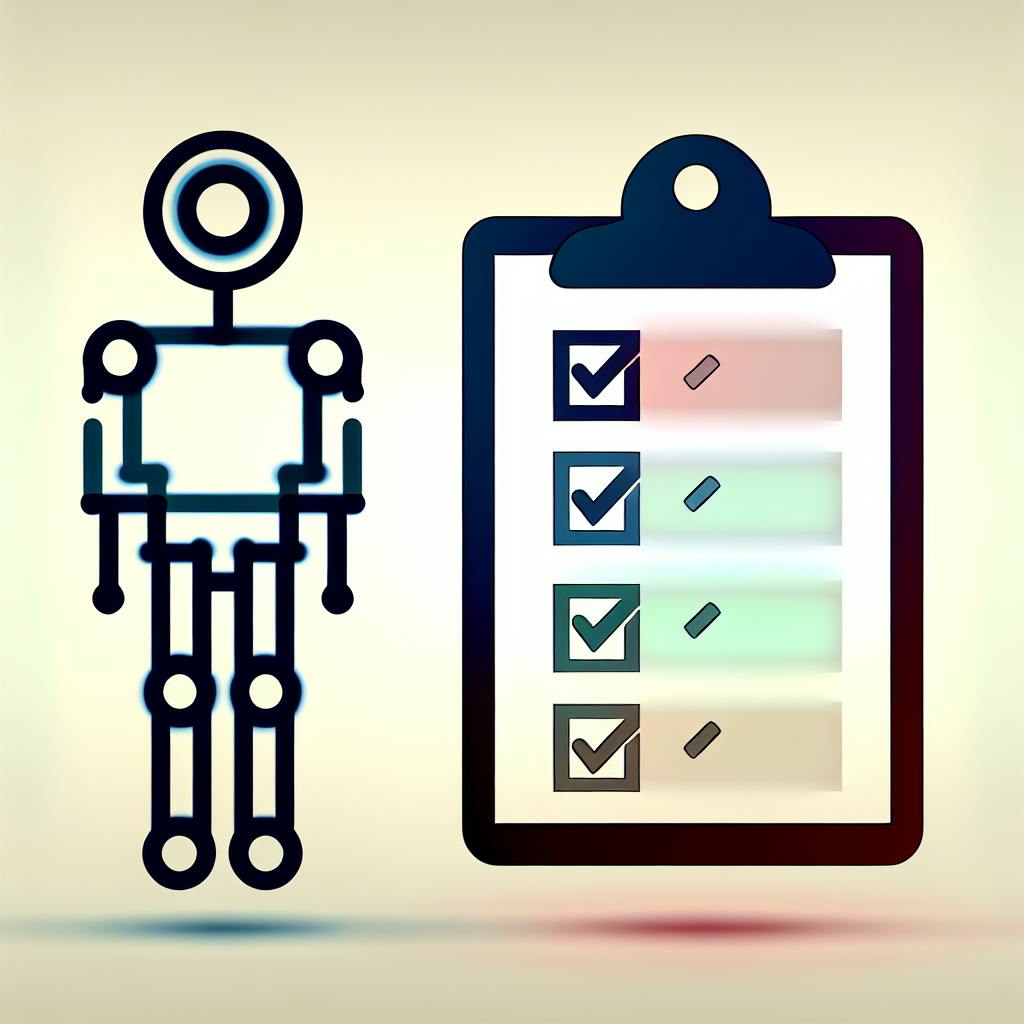Recruitment technology plays a crucial role in optimizing the hiring process and ensuring a strong return on investment (ROI). This guide focuses on two key metrics: time-to-hire and quality-of-hire.
Time-to-Hire
- Measures the duration from when a candidate applies to when they accept a job offer
- Reducing this time can boost productivity, lower costs, and improve the candidate experience to attract top talent
Quality-of-Hire
- Evaluates the long-term value and impact of new hires based on factors like performance, cultural fit, and retention rates
- Helps assess the effectiveness of hiring strategies
By mastering these metrics and leveraging recruitment technology, organizations can streamline their hiring process, attract and retain top talent, and drive business success.
Related video from YouTube
Balancing Time-to-Hire and Quality-of-Hire
| Shorter Time-to-Hire | Longer Time-to-Hire |
|---|---|
| Faster filling of vacancies | More thorough candidate evaluation |
| Risk of overlooking critical steps | Risk of losing top talent to competitors |
| Higher chance of hiring unsuitable candidates | Operational inefficiencies due to prolonged vacancies |
Striking the right balance between these metrics is crucial for optimizing recruitment outcomes and maximizing ROI.
Key Factors Affecting Recruitment Tech ROI
| Factor | Description |
|---|---|
| Cost to Hire | Expenses related to job advertising, recruitment agency fees, background checks, and recruitment team salaries |
| Time-to-Fill | Duration to fill a vacant position, impacting productivity and opportunity costs |
| Quality of Hire | Performance, cultural fit, and retention rates of new hires, directly affecting organizational success |
| Employee Retention | High turnover rates can negate the benefits of recruitment technologies, requiring frequent hiring and training |
Maximizing Recruitment Tech ROI
To maximize the ROI from recruitment tech, organizations should focus on:
| Focus Area | Benefits |
|---|---|
| Optimizing implementation | – Streamline workflows – Automate tasks – Enhance candidate experience |
| Making data-driven decisions | – Identify bottlenecks – Align with organizational goals – Make informed decisions |
| Embracing continuous improvement | – Stay up-to-date with trends – Adopt new technologies – Refine processes |
By leveraging recruitment technology and implementing best practices, companies can optimize both time-to-hire and quality-of-hire, ensuring an efficient hiring process that attracts and retains top talent.
What is Recruitment Tech ROI?
Defining Recruitment Tech ROI
Recruitment tech ROI (return on investment) measures the value gained from investing in recruitment technologies and tools. It compares the costs of implementing and using these tools against the benefits they provide, such as:
- Faster hiring
- Better quality hires
- Reduced time-to-hire
Why Track ROI?
Tracking recruitment tech ROI offers these advantages:
- Cost Savings: It helps identify areas to optimize recruitment costs and allocate resources effectively.
- Data-Driven Decisions: By quantifying the impact of recruitment technologies, organizations can decide which tools to invest in or discontinue.
- Goal Alignment: Measuring ROI ensures recruitment technology investments align with overall business goals and contribute to success.
- Investment Justification: Clear ROI metrics provide a strong case for investing in recruitment technologies, helping secure stakeholder buy-in.
Key Factors Affecting ROI
Several key factors influence recruitment tech ROI:
| Factor | Description |
|---|---|
| Cost to Hire | Expenses related to job advertising, recruitment agency fees, background checks, and recruitment team salaries. |
| Time-to-Fill | The duration it takes to fill a vacant position, impacting productivity and opportunity costs. |
| Quality of Hire | The performance, cultural fit, and retention rates of new hires, directly affecting organizational success. |
| Employee Retention | High turnover rates can negate the benefits of recruitment technologies, requiring frequent hiring and training. |
Measuring Time-to-Hire
What is Time-to-Hire?
Time-to-hire is a key metric that shows how long it takes to fill a job opening. It measures the number of days between when a candidate first applies and when they accept the job offer. A shorter time-to-hire means you can fill open roles faster, reducing costs and boosting productivity.
Calculating Time-to-Hire
To calculate time-to-hire:
- Note the date the candidate applied or was first sourced.
- Note the date the candidate accepted the job offer.
- Count the number of calendar days between these two dates.
Time-to-hire = Date of offer acceptance – Date of application
For example, if a candidate applied on May 1st and accepted the offer on May 20th, the time-to-hire would be 19 days.
Improving Time-to-Hire
Recruitment technologies can speed up the hiring process and reduce time-to-hire:
- Applicant Tracking Systems (ATS): Automate tasks like resume screening, interview scheduling, and candidate communication.
- Pre-screening Tools: Use online assessments and video interviews to quickly evaluate candidates’ skills and fit.
- Recruitment Chatbots: Engage with candidates 24/7, answering questions, scheduling interviews, and providing updates.
- Recruitment Marketing: Use targeted job ads, social media campaigns, and employee referrals to attract more qualified candidates.
- Background Check Automation: Initiate background checks as soon as a candidate progresses, eliminating delays.
Time-to-Hire Before and After
| Recruitment Stage | Before Recruitment Tech | After Recruitment Tech |
|---|---|---|
| Sourcing | 10 days | 5 days |
| Screening | 14 days | 7 days |
| Interviewing | 12 days | 8 days |
| Background Checks | 7 days | 3 days |
| Offer Acceptance | 5 days | 2 days |
| Total Time-to-Hire | 48 days | 25 days |
sbb-itb-32d91a1
Measuring Quality-of-Hire
What is Quality-of-Hire?
Quality-of-hire measures how well a new employee performs and contributes to the company’s success. It evaluates how the new hire fits within the work environment and culture. Assessing quality-of-hire is crucial because it directly impacts productivity, employee satisfaction, retention, and ultimately, the bottom line.
Key Quality-of-Hire Metrics
Several metrics are used to gauge the quality-of-hire:
- Employee Performance: How well the new hire performs in their role, based on productivity, goal achievement, and performance reviews.
- Retention Rate: How long new hires remain with the company, indicating job satisfaction and cultural fit.
- Cultural Fit: How well the new hire aligns with the company’s values, work environment, and team dynamics.
- Hiring Manager Satisfaction: The hiring manager’s level of satisfaction with the new hire’s skills, performance, and overall fit for the role.
- New Hire Engagement: The new hire’s level of engagement, motivation, and commitment to the company and their role.
Improving Quality with Tech
Recruitment technologies can enhance the quality-of-hire by leveraging data insights, matching algorithms, and streamlined processes:
| Technology | Impact |
|---|---|
| Applicant Tracking Systems (ATS) | Automate resume screening and candidate ranking based on predefined criteria, ensuring only qualified candidates move forward. |
| Pre-employment Assessments | Evaluate candidates’ skills, aptitudes, and cultural fit through online assessments, providing a comprehensive understanding of their potential. |
| Recruitment Analytics | Analyze data from various sources to identify top-performing candidate sources, optimize job descriptions, and refine hiring processes. |
| Candidate Relationship Management (CRM) | Nurture and engage with top talent through personalized communication and targeted campaigns, improving the candidate experience and increasing the likelihood of attracting high-quality hires. |
Quality-of-Hire Metrics Impact
| Metric | Impact of Recruitment Technology |
|---|---|
| Employee Performance | Improved candidate matching and assessment lead to hiring top performers who excel in their roles. |
| Retention Rate | Better cultural fit and job satisfaction result in higher retention rates and reduced turnover costs. |
| Cultural Fit | Advanced assessments and data insights help identify candidates who align with the company’s values and work environment. |
| Hiring Manager Satisfaction | Streamlined processes and better candidate evaluation result in hiring managers being more satisfied with the quality of new hires. |
| New Hire Engagement | Personalized candidate experience and effective onboarding processes facilitated by recruitment tech lead to higher engagement and commitment from new hires. |
Balancing Speed and Quality in Hiring
The Trade-off
Time-to-hire and quality-of-hire are often seen as competing goals in recruitment. A shorter time-to-hire can lead to rushed decisions, compromising the quality of new hires. On the other hand, an excessive focus on quality-of-hire can prolong the hiring process, resulting in operational delays and missed opportunities.
| Metric | Potential Impact |
|---|---|
| Shorter Time-to-Hire | – Faster filling of vacancies, maintaining productivity – Risk of overlooking critical candidate evaluation steps – Higher chance of hiring unsuitable candidates |
| Longer Time-to-Hire | – More thorough candidate evaluation and assessment – Risk of losing top talent to competitors – Operational inefficiencies due to prolonged vacancies |
Striking the right balance between these metrics is crucial for optimizing recruitment outcomes and maximizing return on investment (ROI).
Why Balance Matters
Achieving equilibrium between time-to-hire and quality-of-hire is essential for several reasons:
-
Operational Efficiency: Vacant positions can strain existing employees and impact productivity. Filling roles promptly while ensuring quality hires maintains operational efficiency.
-
Cost Control: A lengthy hiring process increases costs, while hasty hires can lead to poor performance, increased turnover, and additional recruitment expenses.
-
Competitive Edge: Top talent is in high demand. Balancing speed and quality enables organizations to secure the best candidates before competitors.
-
Employee Engagement: High-quality hires who fit the company culture are more likely to be engaged, productive, and committed, reducing turnover costs.
Compromising either metric can have detrimental effects on the organization’s performance, culture, and bottom line.
Leveraging Technology
Recruitment technologies can help organizations optimize both time-to-hire and quality-of-hire simultaneously:
-
Applicant Tracking Systems (ATS): Automate resume screening and candidate ranking, streamlining the initial stages while ensuring only qualified candidates move forward.
-
Pre-employment Assessments: Evaluate candidates’ skills, aptitudes, and cultural fit through online assessments, providing a comprehensive understanding of their potential without prolonging the process.
-
Recruitment Analytics: Analyze data to identify top-performing candidate sources, optimize job descriptions, and refine hiring processes for efficiency and effectiveness.
-
Candidate Relationship Management (CRM): Nurture and engage with top talent through personalized communication and targeted campaigns, improving the candidate experience and increasing the likelihood of attracting high-quality hires quickly.
-
Video Interviewing: Conduct initial interviews remotely, saving time and resources while allowing for a more comprehensive evaluation of candidates.
-
Collaborative Hiring Tools: Enable seamless collaboration between hiring teams, streamlining decision-making and reducing delays.
Calculating Recruitment Tech ROI
Steps to Calculate ROI
1. Identify Recruitment Costs: List all expenses related to your hiring process, like job ads, applicant tracking system fees, pre-employment tests, background checks, and recruitment agency fees (if used).
2. Determine Time-to-Hire: Measure the average time it takes to fill a position, from job posting to offer acceptance. This impacts operational efficiency and productivity.
3. Evaluate Quality-of-Hire: Assess the performance, engagement, and retention rates of new hires. High-quality hires contribute to increased productivity, reduced turnover, and overall organizational success.
4. Quantify Benefits: Estimate the tangible and intangible benefits of using recruitment technologies, such as time savings, improved candidate experience, better cultural fit, and increased employee productivity.
5. Calculate ROI: Use the formula: ROI = (Benefits – Costs) / Costs. Divide the net benefits (benefits minus costs) by the total recruitment costs to determine the return on investment.
Factors to Consider
- Implementation Costs: Include one-time setup fees, integration expenses, and training costs for new recruitment technologies.
- Ongoing Maintenance: Account for recurring costs like software subscriptions, upgrades, and support fees.
- Time Savings: Quantify the time saved by automating manual tasks, streamlining processes, and reducing time-to-hire.
- Quality Improvements: Consider the long-term benefits of better cultural fit, increased employee engagement, and reduced turnover.
- Opportunity Costs: Factor in the potential revenue lost due to prolonged vacancies or underperforming hires.
ROI Calculation Formula
ROI = (Benefits – Costs) / Costs
Where:
- Benefits = Time Savings + Increased Productivity + Reduced Turnover Costs + Improved Candidate Experience
- Costs = Implementation Costs + Ongoing Maintenance Costs + Recruitment Costs
ROI Calculation Example
| Cost/Benefit Component | Value |
|---|---|
| Costs | |
| Implementation Costs | $10,000 |
| Annual Subscription | $5,000 |
| Recruitment Costs (per hire) | $3,000 |
| Total Costs (for 50 hires) | $160,000 |
| Benefits | |
| Time Savings (per hire) | $1,500 |
| Increased Productivity (per hire) | $10,000 |
| Reduced Turnover Costs (per hire) | $2,000 |
| Improved Candidate Experience | $20,000 |
| Total Benefits (for 50 hires) | $685,000 |
| ROI Calculation | |
| ROI = (Benefits – Costs) / Costs | ($685,000 – $160,000) / $160,000 = 3.28 or 328% |
In this example, the recruitment technology investment yields a 328% return on investment, showing a significant positive impact on the organization’s bottom line.
Getting the Most from Your Recruitment Tech
Smart Implementation
To get the best return on your recruitment tech investment, start with a thorough review of your current hiring process. Pinpoint areas where technology can streamline tasks and enhance the candidate experience. Involve key team members like hiring managers and recruiters to understand their needs and ensure smooth adoption.
Provide comprehensive training so your team can use the new tools effectively. Set clear guidelines and best practices. Monitor usage and gather feedback to refine your implementation strategy continuously.
Data-Driven Decisions
Use data from your recruitment tools to gain insights into your hiring process. Analyze metrics like:
- Time-to-hire
- Source of hire
- Candidate drop-off rates
- Quality-of-hire
Identify bottlenecks and areas for improvement. Leverage predictive analytics and AI to make data-driven decisions about sourcing, screening, and selection.
Continuously monitor and adjust your strategies based on data insights, ensuring your recruitment efforts align with organizational goals and deliver measurable results.
Continuous Improvement
Recruitment tech is constantly evolving. Regularly review and assess your tools’ performance, and be open to adopting new technologies or upgrading existing ones as needed.
Encourage your recruitment team to stay up-to-date with industry trends, attend training sessions, and explore new features that can enhance their productivity and effectiveness.
Gather feedback from candidates, hiring managers, and stakeholders to identify areas for improvement. Use this feedback to refine your processes, enhance the candidate experience, and ensure your recruitment technology remains aligned with your organizational needs and goals.
Key Points
| Action | Benefit |
|---|---|
| Optimize implementation | Streamline workflows, automate tasks, enhance candidate experience |
| Use data insights | Identify bottlenecks, make data-driven decisions, align with goals |
| Continuously improve | Stay ahead of trends, adopt new tech, refine processes |
Conclusion
Measuring and improving the return on investment (ROI) from recruitment technologies is vital for companies to attract top talent, cut hiring costs, and drive business growth. By focusing on key metrics like time-to-hire and quality-of-hire, organizations can gain valuable insights into the effectiveness of their recruitment processes and make data-driven decisions to enhance their strategies.
Finding the right balance between time-to-hire and quality-of-hire is crucial. While a shorter time-to-hire can lead to cost savings and faster talent acquisition, it should not sacrifice the quality of new hires. Conversely, prioritizing quality-of-hire without considering time-to-hire can result in extended vacancies and lost productivity. By leveraging recruitment technology and implementing best practices, companies can optimize both metrics, ensuring an efficient hiring process that attracts and retains top talent.
To maximize the ROI from recruitment tech, organizations should focus on:
| Focus Area | Benefits |
|---|---|
| Optimizing implementation | – Streamline workflows – Automate tasks – Enhance candidate experience |
| Making data-driven decisions | – Identify bottlenecks – Align with organizational goals – Make informed decisions |
| Embracing continuous improvement | – Stay up-to-date with trends – Adopt new technologies – Refine processes |
Key Takeaways
- Measuring recruitment tech ROI is vital for attracting top talent, reducing costs, and driving business growth.
- Time-to-hire and quality-of-hire are critical metrics that should be balanced for optimal recruitment outcomes.
- Leveraging recruitment technology and implementing best practices can help optimize both time-to-hire and quality-of-hire.
- To maximize recruitment tech ROI, organizations should:
- Optimize implementation
- Make data-driven decisions
- Embrace continuous improvement
- Companies should focus on streamlining workflows, automating tasks, enhancing the candidate experience, identifying bottlenecks, and staying up-to-date with industry trends and new technologies.
FAQs
How is ROI measured for recruitment?
The formula to calculate recruitment ROI is:
ROI = (Employee Value – Hiring & Retention Costs) / Hiring & Retention Costs
Where:
- Employee Value includes increased revenue, profits, productivity, etc. contributed by the employee.
- Hiring Costs cover expenses like job ads, agency fees, background checks, and time spent by HR and hiring managers.
- Retention Costs include the employee’s salary, benefits, training costs, etc.
This formula considers both the value added by the employee and the costs of acquiring and retaining them.
How to calculate ROI for talent acquisition?
The formula to calculate talent acquisition ROI is:
ROI = (Number of Hires × Average Salary of Hires) / Total Hiring Costs
For example, if you made 10 hires with an average salary of $60,000, and the total hiring costs (including advertising, agency fees, etc.) were $50,000, the ROI would be:
ROI = (10 × $60,000) / $50,000 = 12
This means that for every $1 invested in talent acquisition, the company gained a return of $12 in the form of new employee salaries.
This calculation provides a quick snapshot of the immediate return on investment for the recruitment process. However, it does not consider the long-term value added by the employees or the costs of retaining them.
| Calculation | Formula |
|---|---|
| Recruitment ROI | ROI = (Employee Value – Hiring & Retention Costs) / Hiring & Retention Costs |
| Talent Acquisition ROI | ROI = (Number of Hires × Average Salary of Hires) / Total Hiring Costs |




